WEEKEND CROWDSOURCING EVENT YIELDS HOLOCAUST MUSEUM HOUSTON NEW OLD ARTIFACTS AHEAD OF ITS GRAND REOPENING  Note: This story previously stated that the museum had accepted artifacts as donations over the weekend. While the museum has agreed to consider certain items further as donations, it has not officially accepted any of them yet.
Owners of Holocaust-era documents, photographs, and other Jewish WWII memorabilia made their way out to Holocaust Museum Houston’s temporary location in a Kirby Dr. office park south of 610 yesterday between noon and 5pm where curators scrutinized their belongings and — in some cases — agreed to consider them further as potential donations. If accepted, the new artifacts would help fill up the museum’s more permanent home at 5401 Caroline St., which is scheduled to reopen in June having more than doubled in size to 57,000 sq.-ft. since last year. At least 2 of its mainstay exhibits are already there: a 25.7-ft.-long German rail car like those used to carry Jews to their deaths during the war and a 37.1-ft Danish fishing boat of the type used to rescue thousands of them in 1943. After being moved over to an adjacent lot in early last year, a crane airlifted the 2 vessels back onto the grounds of the museum in May so that a new portion of the campus they belong to could be built around them as part of the expansion. [Previously on Swamplot] Rendering of museum expansion: Holocaust Museum Houston
Note: This story previously stated that the museum had accepted artifacts as donations over the weekend. While the museum has agreed to consider certain items further as donations, it has not officially accepted any of them yet.
Owners of Holocaust-era documents, photographs, and other Jewish WWII memorabilia made their way out to Holocaust Museum Houston’s temporary location in a Kirby Dr. office park south of 610 yesterday between noon and 5pm where curators scrutinized their belongings and — in some cases — agreed to consider them further as potential donations. If accepted, the new artifacts would help fill up the museum’s more permanent home at 5401 Caroline St., which is scheduled to reopen in June having more than doubled in size to 57,000 sq.-ft. since last year. At least 2 of its mainstay exhibits are already there: a 25.7-ft.-long German rail car like those used to carry Jews to their deaths during the war and a 37.1-ft Danish fishing boat of the type used to rescue thousands of them in 1943. After being moved over to an adjacent lot in early last year, a crane airlifted the 2 vessels back onto the grounds of the museum in May so that a new portion of the campus they belong to could be built around them as part of the expansion. [Previously on Swamplot] Rendering of museum expansion: Holocaust Museum Houston
Tag: Museums
LEAGUE CITY’S LONGHORN CATTLE MUSEUM REOPENS 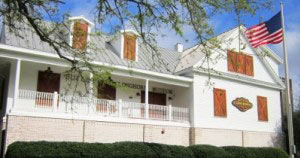 All bovine exhibits at the house-turned-museum-and-events-venue at 1220 Coryell St. are now back on view following months of renovations to address flood damage, reports the Chronicle’s Jennifer Bolton. Opened in 2009, The Butler Longhorn Museum, focuses specifically on the iconic cattle breed and the 19th century efforts of the Butler family, members of which helped save the animals from extinction through work on their land in what’s now League City, Kemah, Friendswood, and a few mainland portions of Galveston County. “While most of the exhibits could be — and were — redone, there were murals painted on the downstairs walls of the museum that had to be torn apart,” reports Bolton. Also out of commission: a separate education building that sits on the same 10 acres as the museum itself. [Houston Chronicle] Photo: Butler Longhorn Museum
All bovine exhibits at the house-turned-museum-and-events-venue at 1220 Coryell St. are now back on view following months of renovations to address flood damage, reports the Chronicle’s Jennifer Bolton. Opened in 2009, The Butler Longhorn Museum, focuses specifically on the iconic cattle breed and the 19th century efforts of the Butler family, members of which helped save the animals from extinction through work on their land in what’s now League City, Kemah, Friendswood, and a few mainland portions of Galveston County. “While most of the exhibits could be — and were — redone, there were murals painted on the downstairs walls of the museum that had to be torn apart,” reports Bolton. Also out of commission: a separate education building that sits on the same 10 acres as the museum itself. [Houston Chronicle] Photo: Butler Longhorn Museum
AN OPENING-NIGHT BRAWL AT CAM STARTED WITH A FEW LOAVES OF BREAD 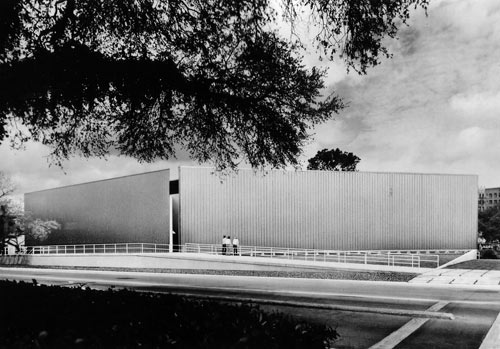 One highlight of Pete Gershon’s new book about Houston’s ’70s and ’80s art scene is his description of the all-out melee that erupted in the Contemporary Arts Museum’s upper gallery at the opening night of an exhibition put on by Spanish artist Antoni Miralda in 1977. Notorious for his work with food, Miralda, writes Gershon, had “hung color photographs of brightly hued macaroni, labeled huge mounds of salt and sugar with garishly flashing neon signs, and showed videos . . . of food being prepared and eaten in restaurants from around Houston.” The centerpiece was “four thousand loaves of bread dyed with food coloring” which performers placed “on a 175-foot row of benches bisecting the exhibition space.” Following some nibbling and “the playful tossing of slices,” one “notorious troublemaker from the St. Thomas art crowd,” picked up a loaf and chucked it carelessly, hitting a 6-year-old girl and knocking her to the ground. A fellow attendee dragged him out the back entrance to teach him a lesson, but it was too late: “inside the gallery the scene quickly escalated to a full-scale, Texas-sized donnybrook, with flying bread and flying fists.” Fifteen minutes later, management had cleared the room “and mopped up the blood,” adds the museum’s then-director. But his boss worried about the mark it’d left — not just in the minds of those who disapproved but, worse, the ones who “eagerly entered the fray.” Perhaps, writes Gershon, “they thought this happened at CAM all the time.” [Arts and Culture Texas; interview with Pete Gershon] Photo: Contemporary Arts Museum Houston
One highlight of Pete Gershon’s new book about Houston’s ’70s and ’80s art scene is his description of the all-out melee that erupted in the Contemporary Arts Museum’s upper gallery at the opening night of an exhibition put on by Spanish artist Antoni Miralda in 1977. Notorious for his work with food, Miralda, writes Gershon, had “hung color photographs of brightly hued macaroni, labeled huge mounds of salt and sugar with garishly flashing neon signs, and showed videos . . . of food being prepared and eaten in restaurants from around Houston.” The centerpiece was “four thousand loaves of bread dyed with food coloring” which performers placed “on a 175-foot row of benches bisecting the exhibition space.” Following some nibbling and “the playful tossing of slices,” one “notorious troublemaker from the St. Thomas art crowd,” picked up a loaf and chucked it carelessly, hitting a 6-year-old girl and knocking her to the ground. A fellow attendee dragged him out the back entrance to teach him a lesson, but it was too late: “inside the gallery the scene quickly escalated to a full-scale, Texas-sized donnybrook, with flying bread and flying fists.” Fifteen minutes later, management had cleared the room “and mopped up the blood,” adds the museum’s then-director. But his boss worried about the mark it’d left — not just in the minds of those who disapproved but, worse, the ones who “eagerly entered the fray.” Perhaps, writes Gershon, “they thought this happened at CAM all the time.” [Arts and Culture Texas; interview with Pete Gershon] Photo: Contemporary Arts Museum Houston
COMMENT OF THE DAY: ANOTHER MFAH STICKER SOLUTION 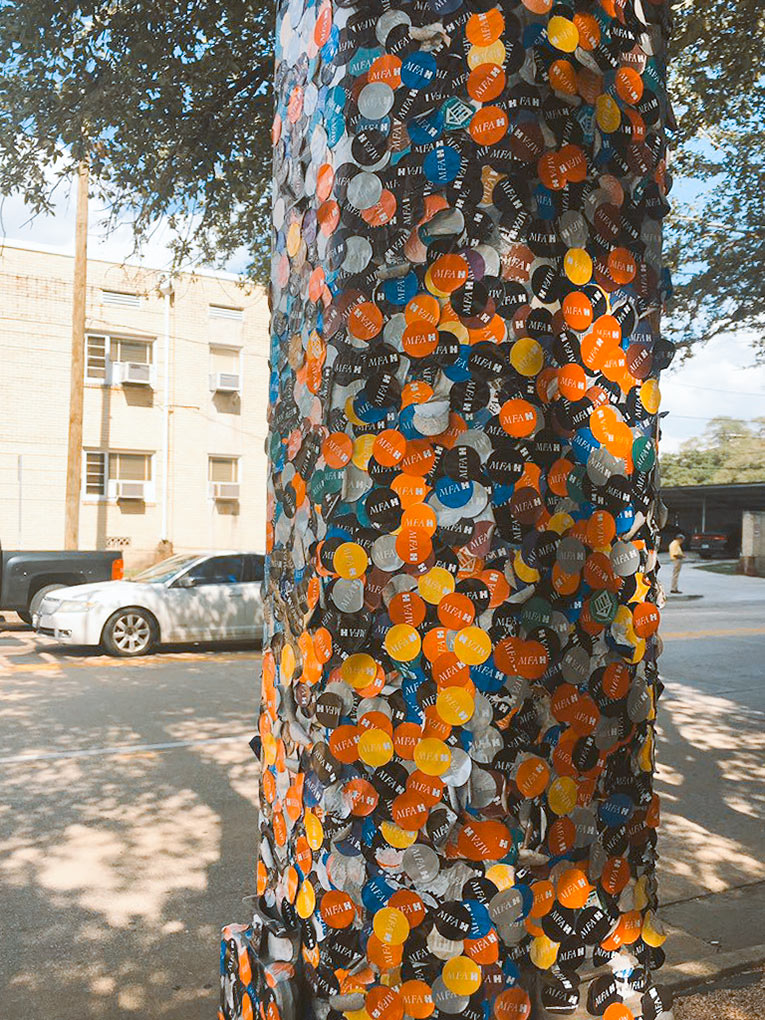 “It will be a sad day in Houston when there are no MFAH stickers stuck to things in the Museum District. You’d think that the museum long ago would have embraced the tradition and added some weird sculpture-looking things in front of all exits that say ‘stick stickers here.’ It would reduce the occurrences of random vandalism by hoodlums. I wonder how many tags they expect to ‘lose’ as part of this experiment?” [toasty, commenting on Flood Bond Passes; Harvey Movie Sets Its Premiere Date; MFAH Stickers Swapped Out for Reusable Tags] Photo of sticker collage at Binz and San Jacinto streets: Alley Lyles
“It will be a sad day in Houston when there are no MFAH stickers stuck to things in the Museum District. You’d think that the museum long ago would have embraced the tradition and added some weird sculpture-looking things in front of all exits that say ‘stick stickers here.’ It would reduce the occurrences of random vandalism by hoodlums. I wonder how many tags they expect to ‘lose’ as part of this experiment?” [toasty, commenting on Flood Bond Passes; Harvey Movie Sets Its Premiere Date; MFAH Stickers Swapped Out for Reusable Tags] Photo of sticker collage at Binz and San Jacinto streets: Alley Lyles
COMMENT OF THE DAY: FORMER INK SPOTS MUSEUM FACES THE MUSIC 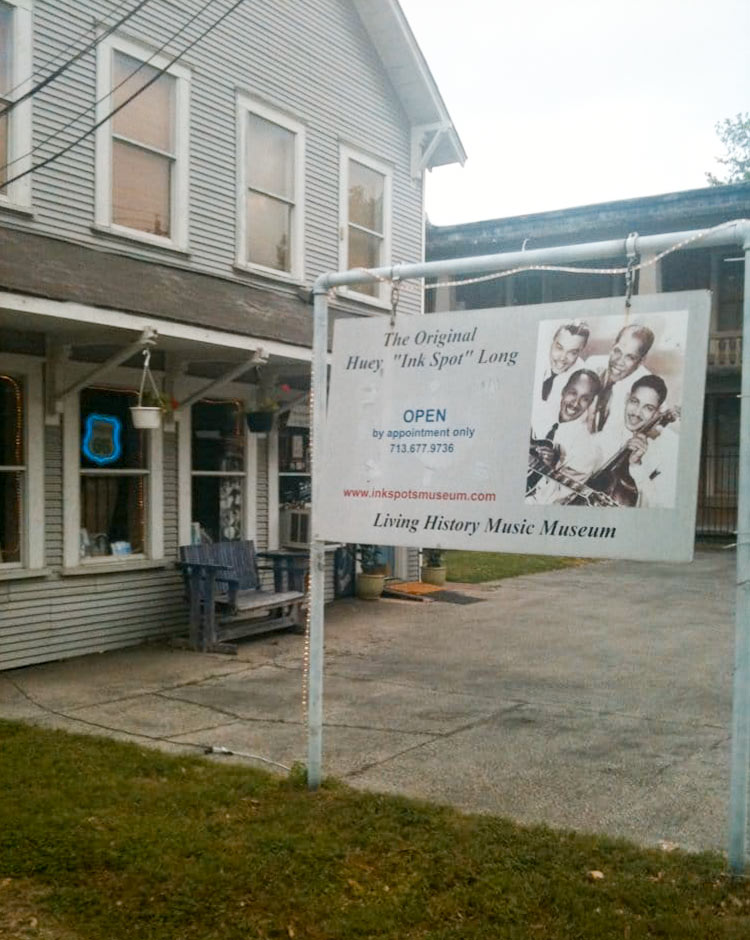 “The building on E. 20th was for years the The Original Huey ‘Ink Spot’ Long Living History Music Museum. Very cool for neighbors, visitors, and especially Hamilton Middle School students to be able to pass by or visit it. The Ink Spots Museum is now online.” [Miz Brook Smith, commenting on Daily Demolition Report: Sampson & Beulah; previously on Swamplot] Photo: Martha D.
“The building on E. 20th was for years the The Original Huey ‘Ink Spot’ Long Living History Music Museum. Very cool for neighbors, visitors, and especially Hamilton Middle School students to be able to pass by or visit it. The Ink Spots Museum is now online.” [Miz Brook Smith, commenting on Daily Demolition Report: Sampson & Beulah; previously on Swamplot] Photo: Martha D.
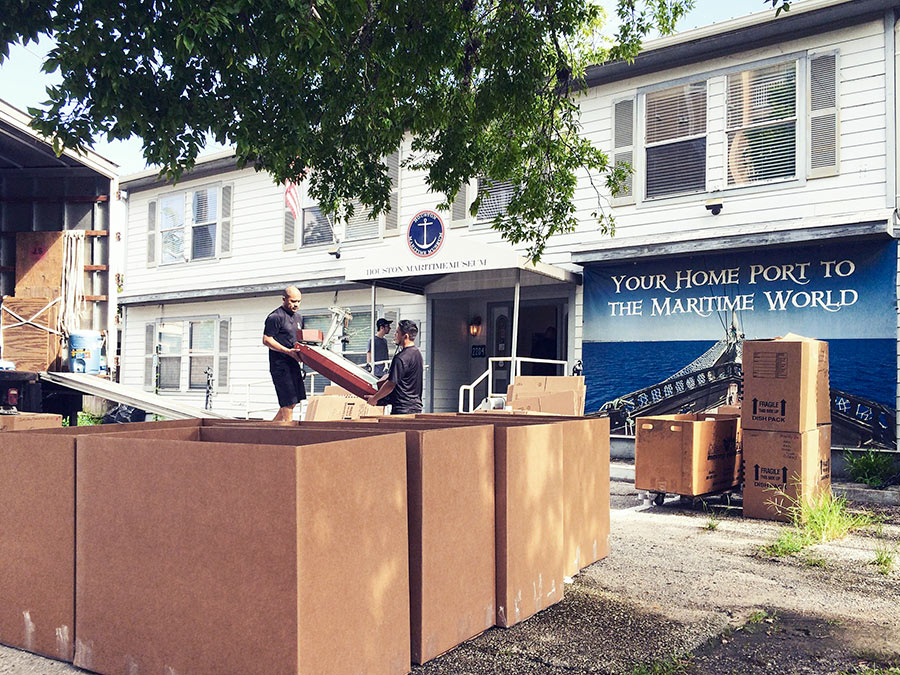
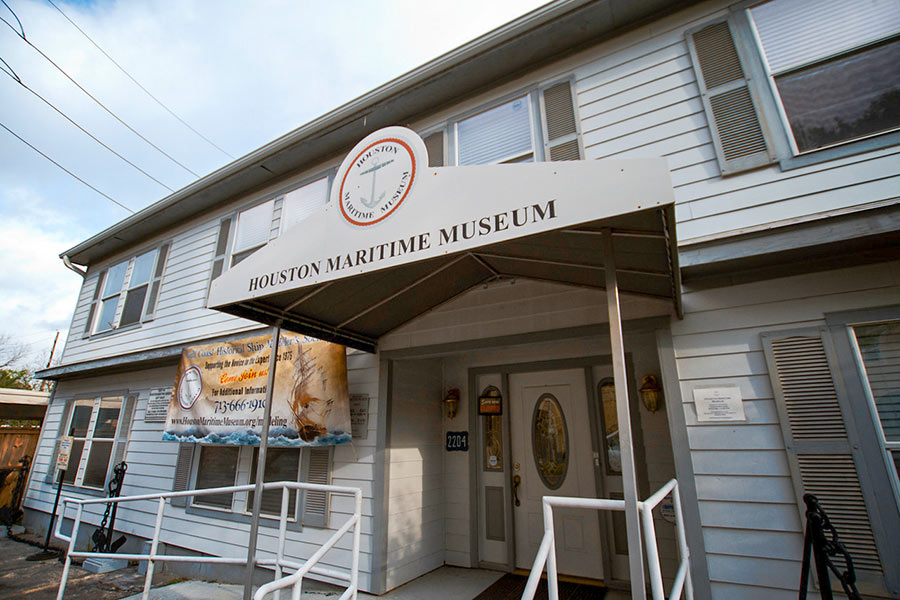
Museum movers are now lugging cargo out of 2204 Dorrington St. as part of the Houston Maritime Museum‘s move to the Second Ward, where it’ll remain landlocked. Two years ago, the museum announced plans to build a new $50 million facility designed by architects at Gensler next to the dock for the Sam Houston boat that conducts tours of the ship channel. But nothing’s opened up yet along that section of waterfront, south of Clinton Dr. and east of Wayside Dr. in Denver Harbor.
In leaving behind its current converted house southwest of the Med Center for new 3-story office-building environs on the corner of Canal and Navigation, the museum will take on a more businesslike appearance than it’s sported so far.
It’ll also get used to sharing its space; existing tenants in the new building include The Polnick Law Firm and Andes Cafe, pictured below from the west:
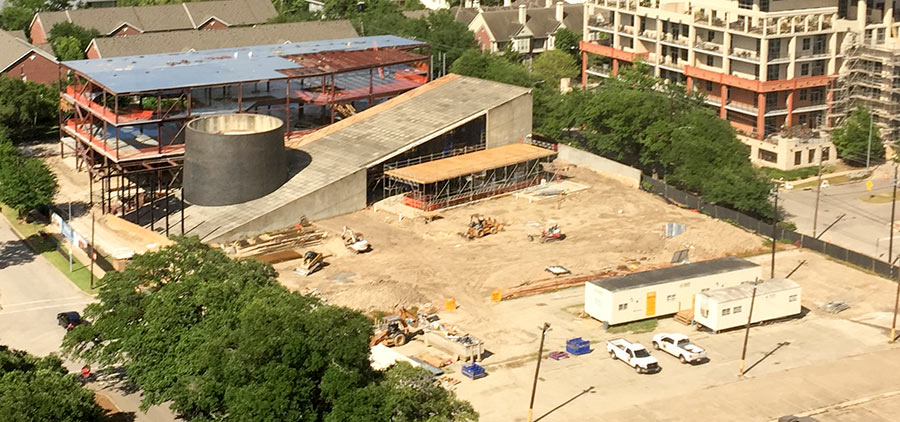
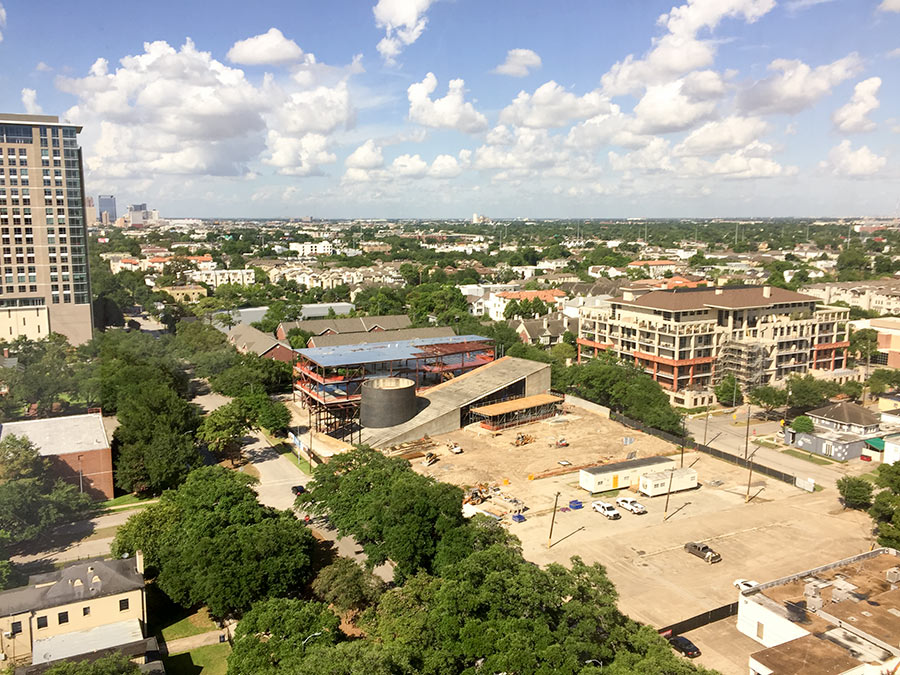
Photos from the 13th floor of the office tower at 1200 Binz St. look northeast to show the state of things at Holocaust Museum Houston’s construction site off Caroline St. Peeking out behind the chimney-like roof cylinder on the existing wedge-shaped building, you can seek 3 stories of steel now standing behind it. They make up a nearly three-times-larger structure now taking shape where the museum’s previous single-story northern building was torn down earlier this year. In its place, the new 57,000- sq.-footer designed by Mucasey & Associates will house a 200-seat theater, bigger exhibition spaces, more classrooms, a larger library, and more offices than its predecessor.
It’ll abut the existing ramped building as shown in the elevation below, with an entrance in between the 2:
THE MENIL DRAWING INSTITUTE: 6 MORE MONTHS 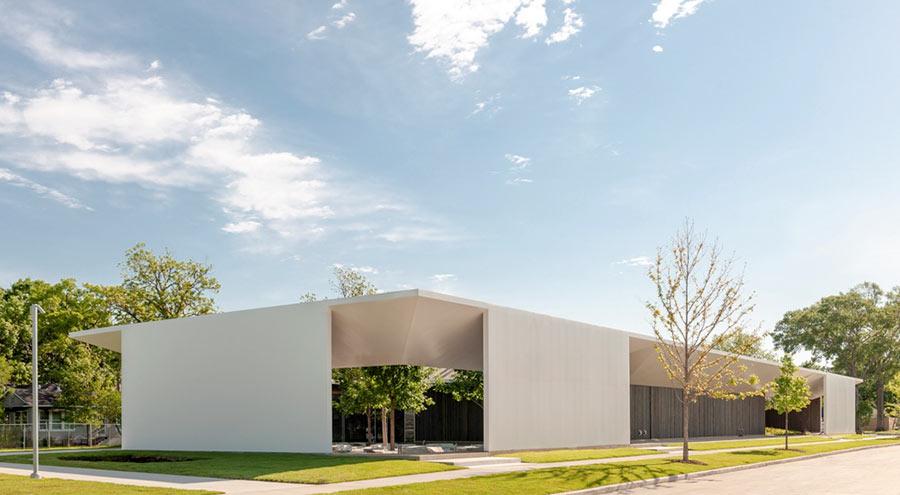 What’s been going on at the Menil Drawing Institute’s new building since its opening — originally scheduled for last October — was postponed over the summer? A lot of sensing and measuring: “It’s extremely important to monitor the climate control and the humidity gauges for a number of months to make sure there are no deviations,†the museum’s director Rebecca Rabinow tells the New York Times’ Andrew R. Chow., outlining what kind of ambiance is required for the paper works the structure will soon house. (Last year’s cold winter didn’t speed things up either — reports the Chronicle’s Molly Glentzer, killing off many of the new plants that had just been installed in the surrounding park according to the plan from landscape architect Michael Van Valkenburgh Associates.) Now that both the indoor and outdoor environments have been stabilized, the official opening date for the 30,000-sq.-ft. building designed by L.A. architect Johnston Marklee has been set: November 3. It will cap off a 3-year building process that began in place of the since-completely-demolished Richmont Square apartments’ backsisde off Branard St. The new structure’s first residents: 41 works on paper by Jasper Johns. [New York Times; previously on Swamplot] Photo of Menil Drawing Institute: Paul Hester/The Menil Collection
What’s been going on at the Menil Drawing Institute’s new building since its opening — originally scheduled for last October — was postponed over the summer? A lot of sensing and measuring: “It’s extremely important to monitor the climate control and the humidity gauges for a number of months to make sure there are no deviations,†the museum’s director Rebecca Rabinow tells the New York Times’ Andrew R. Chow., outlining what kind of ambiance is required for the paper works the structure will soon house. (Last year’s cold winter didn’t speed things up either — reports the Chronicle’s Molly Glentzer, killing off many of the new plants that had just been installed in the surrounding park according to the plan from landscape architect Michael Van Valkenburgh Associates.) Now that both the indoor and outdoor environments have been stabilized, the official opening date for the 30,000-sq.-ft. building designed by L.A. architect Johnston Marklee has been set: November 3. It will cap off a 3-year building process that began in place of the since-completely-demolished Richmont Square apartments’ backsisde off Branard St. The new structure’s first residents: 41 works on paper by Jasper Johns. [New York Times; previously on Swamplot] Photo of Menil Drawing Institute: Paul Hester/The Menil Collection

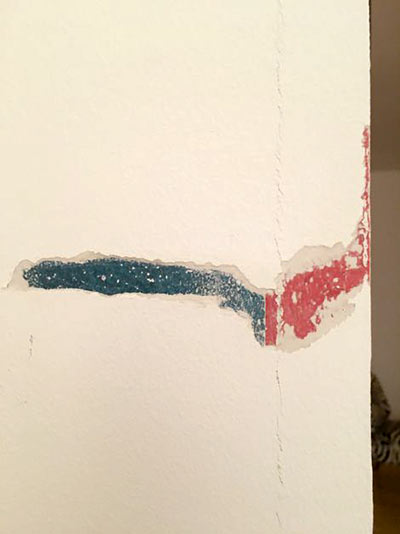
How’s this for a twisting story line? An architect commissions a famous artist to create a site-specific drawing in a house he has built for himself. The artist, who never touches his own works, creates exacting instructions that installation artists follow to create the 30-ft.-tall artwork in the living room of the home. The artist dies. A few years later, the architect dies, offering his home and the majority of his extensive art collection to a local but world-famous museum of which he was a trustee. The museum decides to sell the home and add much of the art to its collection, but there’s a problem with the wall drawing. It can’t be moved, and the museum is stymied by a restriction: It is not allowed to sell any artwork that has been bequeathed to it.
Here’s where the plot — and the drywall mud — thickens: the museum, unable to remove the artwork from the home without destroying it, comes up with an alternative plan. It will plaster over the drawing, rendering it unrecoverable.
Years later, the purchaser of the home is telling this story to a houseguest — who in a fit of curiosity grabs a dull knife and starts chipping away at the wall. The white coating flakes off. To his and his host’s surprise, a tableau of blue, red, and yellow appears: a fragment of the original drawing underneath.
What is this? The first 20 minutes of a new Wes Anderson movie, an episode of Columbo, or the setup for a Siri Hustvedt novel? No, its just the state of play at 1202 Milford St. in the Museum District. The artist is Sol LeWitt. The museum is the Menil Collection. The home is the former residence of Houston architect Bill Stern. And the plotline is still in progress:
GUNNAR BIRKERTS, 1925-2017 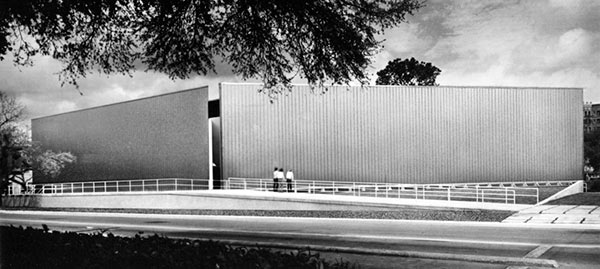 Latvian-born architect Gunnar Birkerts, designer of the stainless-steel-clad Contemporary Arts Museum that’s stood at the northwest corner of Montrose Blvd. and Bissonnet St. since 1972, passed away yesterday at the age of 92. Birkerts moved to Michigan in 1949 after graduating from architecture school in Germany; he later worked in the office of Eero Saarinen and set up his own architectural practice in Birmingham, a Detroit suburb. The exterior of the CAMH was altered to its current appearance in 1997 after a design by Houston architect Bill Stern. [Chicago Tribune; more here] Photo: CAMH
Latvian-born architect Gunnar Birkerts, designer of the stainless-steel-clad Contemporary Arts Museum that’s stood at the northwest corner of Montrose Blvd. and Bissonnet St. since 1972, passed away yesterday at the age of 92. Birkerts moved to Michigan in 1949 after graduating from architecture school in Germany; he later worked in the office of Eero Saarinen and set up his own architectural practice in Birmingham, a Detroit suburb. The exterior of the CAMH was altered to its current appearance in 1997 after a design by Houston architect Bill Stern. [Chicago Tribune; more here] Photo: CAMH
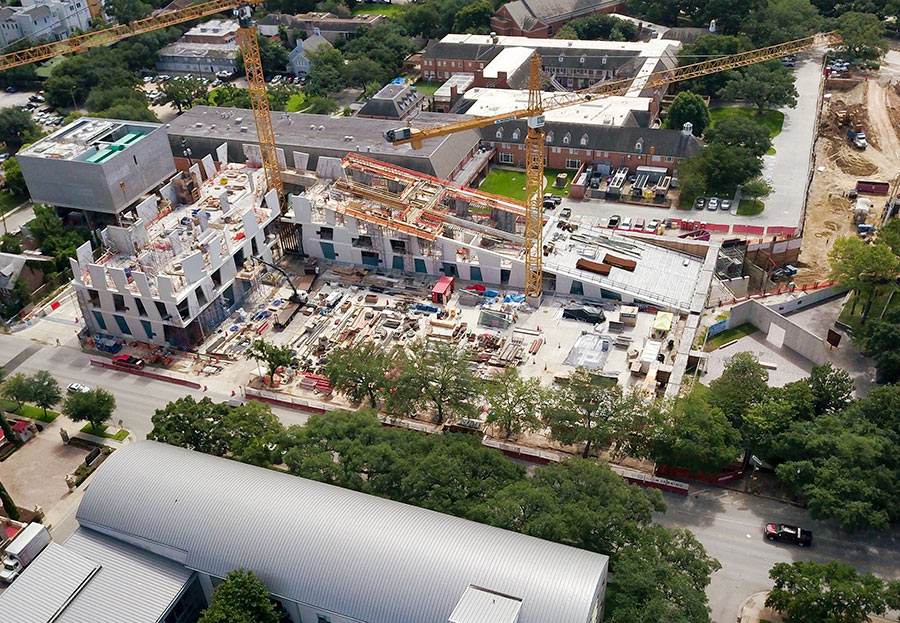
From the skies above Montrose Blvd. just north of Bissonnet, here’s a view from late last week of progress on the Museum of Fine Arts Houston’s new Glassell School of Art. The new building, designed by Steven Holl Architects, is under construction across the street from the Glassell Junior School building (in the foreground, with the curved roof) — and on the same site where the original Glassell School, designed by Houston architect S.I. Morris, was demolished in 2015. Morris’s Glassell School featured exterior walls of glass block; the primary exterior materials of Holl’s replacement building are sandblasted panels of precast concrete, assembled to shape an inclined plane along the long edge of the building’s L shape.
If that part of the building is starting to look like it’ll form a giant ramp, it’s because it will: Models of the structure show an outdoor amphitheater at the ramp’s base; a rooftop public path will ascend beyond it to a sculpture garden on the roof of the building’s northern leg. An addition to the existing sculpture garden to the south will extend into the courtyard shaped by the building’s two wings, fronting Montrose Blvd. The space designated for the garden is filled with construction materials in the center of the photo above; it’s pictured in a more completed state in this rendering by the architect:
YOU WON’T HAVE THE MENIL COLLECTION TO KICK AROUND FOR MOST OF NEXT YEAR Are you one of those architecturally sensitive types who has long suspected that the worn, squishy pine floorboards of Renzo Piano’s Menil Collection building were meant to serve as some sort of metaphor for the tenuous and uncertain nature of Houston’s oft-muddy groundplane? (Plus, they’ve got those underfloor AC registers interrupting it every few yards.) Well, good for you! — but tough luck: Beginning late next February, reports Molly Glentzer, the building will close for 8 months so that those well-worn floors can be refinished. Why should the job take so long? “The staff will continue to operate as usual from the upstairs offices, but some gallery walls will have to be dismantled and the collections shifted through the building during the sanding and finishing process.” Come November 2018, will the experience of walking through the museum be just as exquisitely unstable as it is now? Maybe not: “The leveling mechanisms under the wooden air-conditioning grills in the floor are also being upgraded,” Glentzer warns. Hurry and visit now, while it’s all still worn and creaky! [Houston Chronicle] Video of Sosie Merritt stomping on Menil floors, 2009: Brandon & Kristen Merritt [license]
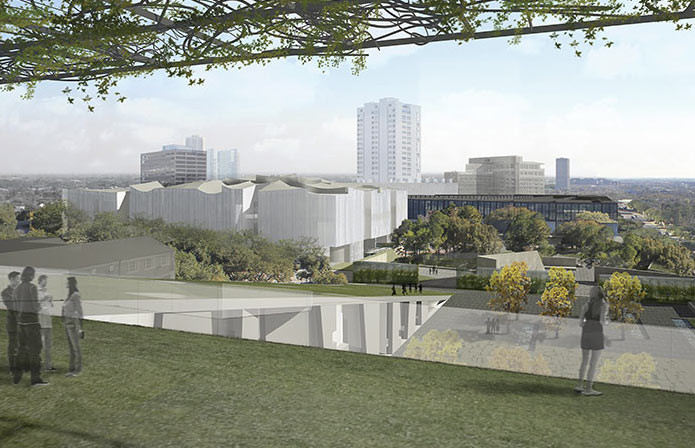
Construction started yesterday on the Nancy and Rich Kinder Building, going up in the Museum of Fine Arts Houston’s former parking lot north of Bissonnet St. at Main. That’s the curvy-roofed structure itself visible in the rendering above — the drawing shows the expected view of the building from the rooftop garden of the already-under-construction nearby replacement for the formerly glass-covered Glassell School (whose underground parking garage opened up when the surface lot closed last week). Both of the new buildings were designed by Steven Holl Architects — here’s where they fall on the map, along some of the other big changes in the works for the Museum’s campus:
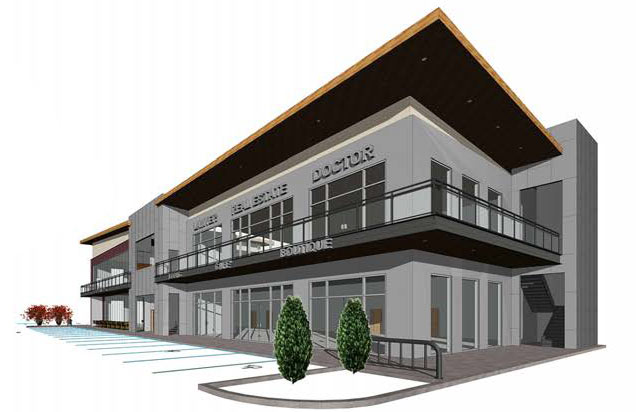
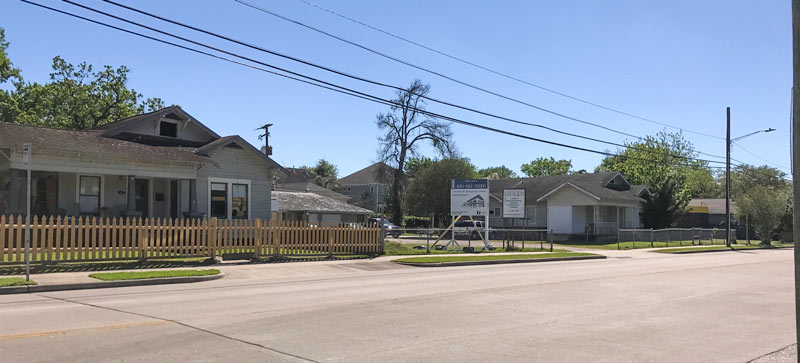
 Retail plans along the stretch of E. 11th St. west of Beverly St. look to be moving in a more concrete direction once again — SRS has started advertising available square footage in a double-decker strip center planned on the eastern half of the block. The design for the site has been totally overhauled since the original ads for a Park Place on 11th development (the weathered signage for which is still hanging around on the property, and has been for the better part of a decade.)
Retail plans along the stretch of E. 11th St. west of Beverly St. look to be moving in a more concrete direction once again — SRS has started advertising available square footage in a double-decker strip center planned on the eastern half of the block. The design for the site has been totally overhauled since the original ads for a Park Place on 11th development (the weathered signage for which is still hanging around on the property, and has been for the better part of a decade.)
The potential footprint of the retail space spreads all the way from Beverly St. to just east of metals brightener Bright Metals of the Heights.  A leasing siteplan shows the center insulated from the 11th St. traffic by a breathable dual layer of parking spaces — and even a triple layer on the Beverly St. side:
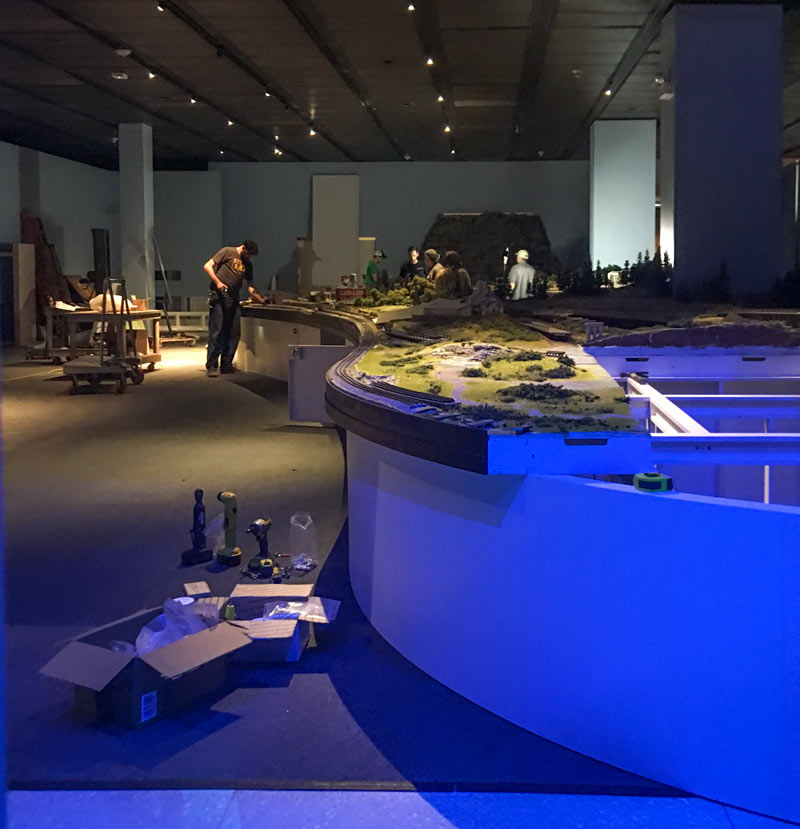
A through-the-curtains peek at at the reassembly of about 2,500 sq. ft. of miniaturized Texas landscape (made by T W Trainworx for the Houston Museum of Natural Science’s soon-to-open model train exhibit) comes from a reader who snuck a glance on Thursday. The exhibit, which should open some time after the 2nd week of installation wraps up, looks like it’ll include hand-carved models of some of Texas’s less flat geographies, including the Balcones Escarpment and Texas’s own pretty darn grand canyon, Palo Duro. The official details on opening and closing dates aren’t out yet, but a behind-the-scenes event description on the museum’s website notes that the exhibit will also show off some more familiar Gulf Coast features like “oil country salt domes, prairies and wetlands.” Natural stone landmarks, like Enchanted Rock, and unnatural stone monuments, like the state capitol, will also be part of the display.
Photo: Swamplot inbox

